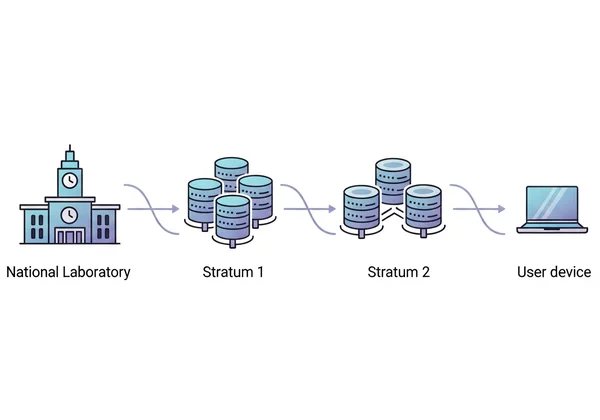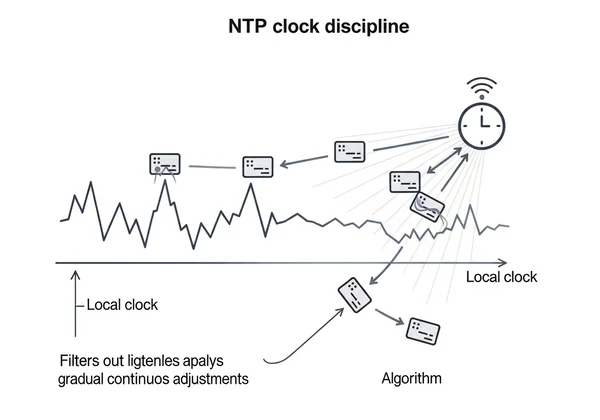Atomic Clock Precision: How a Professional Online Digital Clock Syncs with NTP Time Servers
How truly accurate is your computer's clock? In a hyper-connected world where split-second decisions impact financial trades, scientific research, and global logistics, a standard clock that drifts by milliseconds can become a serious liability. Our precision online digital clock has been engineered to achieve atomic-level accuracy through a robust implementation of server-side synchronization—providing microsecond precision that meets the rigorous demands of professionals everywhere.
The Science Behind Atomic Time: From Cesium Atoms to Your Screen
Time measurement has evolved from sundials to quantum-level precision. Understanding this journey from ancient astronomy to modern physics reveals why a professional timekeeping tool is so essential today.
Understanding International Atomic Time (TAI) and Coordinated Universal Time (UTC)
So, what is the source of this incredible accuracy? It starts with atomic clocks, which measure time by counting the oscillations of cesium-133 atoms—a staggering 9,192,631,770 vibrations define one second under International Atomic Time (TAI). But since Earth's rotation isn't perfectly consistent, we use Coordinated Universal Time (UTC), which adds "leap seconds" when needed to keep atomic time aligned with our planet. Our atomic time service syncs with UTC sources, so you always see the globally standardized reference time, whether coordinating with Tokyo traders or Parisian researchers.

Why Cesium-133 Atomic Clocks Remain the Gold Standard of Timekeeping
Unlike the quartz oscillators in most consumer devices, which can drift up to one second per day, cesium atomic clocks maintain an accuracy of about one second over 1.4 million years. By connecting our digital clock infrastructure to servers that reference these atomic masters, we deliver timetable precision previously only accessible to major institutions. This eliminates the nagging doubt of whether your device's internal clock has fallen behind schedule.
The Journey from National Labs to Your Browser: How Atomic Time Travels
The leap from a shielded national laboratory to your browser is a marvel of modern engineering:
- Primary reference clocks at institutions like NIST (USA) or PTB (Germany) set the standard.
- Stratum 1 servers connect directly to these atomic references.
- Our synchronized network pulls from these sources to ensure the time displayed is accurate.
- Secure transmission delivers that precise time to your device instantly.
Visualization: Atomic Lab → Precision Timekeeping Server Cluster → Your Browser

NTP Demystified: The Protocol That Powers Our Online Digital Clock
Ever wonder why your computer clock sometimes jumps forward or backward? That's what Network Time Protocol (NTP) concepts are designed to prevent. It's not just a simple sync tool—it’s a sophisticated system that intelligently compensates for the messy realities of the internet.
How NTP Layers Work: Stratum Levels and Hierarchical Time Distribution
Our atomic-synced digital clock relies on a multi-tiered architecture for maximum reliability:
- Stratum 0: The atomic clocks themselves, housed at national laboratories.
- Stratum 1: Servers directly connected to these clocks (our primary time sources).
- Stratum 2: Our distributed servers that cross-check for accuracy.
This hierarchy creates powerful redundancy. Should one source become unavailable, the system relies on the next most accurate source using advanced clock selection algorithms.
The Clock Discipline Algorithm: Correcting Network Latency and Drift
Standard clocks simply reset themselves periodically, causing jarring time jumps. Professional synchronization uses a smarter approach:
- Offset Measurement: It compares local and server times across multiple data exchanges.
- Jitter Filtering: It discards statistically unusual readings caused by network lag.
- Smooth Adjustment: It gradually adjusts the display—like a conductor fine-tuning a metronome—for a seamless correction.
The result is smooth, continuous time display, which is critical for applications like livestream coordination or event timing.

Why Multiple Time Servers Ensure Maximum Reliability and Accuracy
We synchronize with independent time sources simultaneously. This strategy allows our online digital clock to:
- Provide reliable uptime.
- Cross-determine the most accurate "true time" from multiple samples.
- Mitigate regional network latency effects.
This robust system explains why our precision timekeeping tool maintains a significantly lower offset compared to uncalibrated device clocks.
Beyond Theory: How Our Online Digital Clock Implements Precision
Engineering excellence is what separates a functional clock from a true precision instrument. Here’s a look at what happens behind our minimalist interface:
Redundant Server Architecture
While many simple clocks rely on basic system time, we maintain:
- Optimized hosting to reduce server response time.
- Routing logic that directs data efficiently based on your location.
- Health monitoring that ensures the service is always available.
Error Correction Methods That Guarantee Accuracy
Our custom systems apply sophisticated techniques to ensure your online digital clock is always accurate:
- Statistical Algorithms: We filter out network "noise" to find the true time.
- Latency Compensation: We actively estimate the time it takes for data to travel to your browser.
Real-World Impact: When Microsecond Accuracy Matters Most
Precision timekeeping stops being theoretical when milliseconds translate into mission-critical consequences.
Financial Markets: How Precision Affects Trading
Traders and analysts need absolute certainty. For these users, a professional timekeeping tool provides:
-
Accurate timestamps for logging activities.
-
Synchronized countdowns for market opening events.
-
A clear UTC display for comparing international market sessions.

Scientific Research: Why Experimentation Requires Synchronization
Pharmaceutical trials, physics experiments, and climate simulations all demand absolute precision for:
- Event sequencing accuracy.
- Traceable UTC timestamps for study replication.
- High-visibility displays that are easily readable across laboratories.
Global Operations: How a Synchronized Online Clock Benefits Teams
Key features for international coordination include:
- Universal Time reference for scheduling across time zones like Shanghai, Berlin, and San Francisco.
- Full-screen mode for clear visibility in meeting rooms.
- Customizable colors to match your workspace environment or reduce eye strain.
Using a synchronized reference clock can significantly reduce meeting delays and coordination errors in distributed teams.
Your Precision Timekeeping Questions Answered
How accurate is this online digital clock compared to others?
While standard browser clocks can accumulate drift based on your OS settings, our tool verifies against external servers to ensure the display remains true to atomic standards. For the most reliable experience, our technology is second to none.
What happens if the internet connection drops?
Our system is designed for resilience:
- The clock continues to run based on the last synchronized high-precision time.
- It automatically attempts to re-sync as soon as the connection is restored.
Does network location affect the accuracy of the online clock?
Minimally. Thanks to latency compensation, variance is kept to the absolute minimum physically possible by your internet connection speed.
How often does this online digital clock sync?
Our system performs periodic checks to ensure alignment. It is in a state of constant validation to keep your display perfectly aligned with global standards.
Precision You Can Trust in Every Second
This precision online digital clock transforms your browser into a reliable chronometer through meticulous synchronization—giving educators, engineers, and executives the confidence that every second reflects global timekeeping standards.
Key takeaways:
- High precision powered by server-side synchronization.
- Redundant connections to certified atomic time sources.
- Continuous accuracy verification that exceeds consumer requirements.
Don't settle for estimates. Experience atomic precision now with our leading digital clock—where every second counts.
Precision engineered. Globally synchronized. Always free—because every millisecond matters.